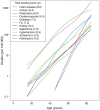Healthy, Active Aging for People and Dogs
- PMID: 34164450
- PMCID: PMC8215343
- DOI: 10.3389/fvets.2021.655191
Healthy, Active Aging for People and Dogs
Abstract
Dogs act as companions who provide us with emotional and physical support. Their shorter lifespans compel us to learn about the challenges and gifts of caring for older individuals. Our companion dogs can be exemplars of healthy or unhealthy aging, and sentinels of environmental factors that might increase or decrease our own healthy lifespan. In recent years, the field of aging has emphasized not just lifespan, but healthspan-the period of healthy, active lifespan. This focus on healthy, active aging is reflected in the World Health Organization's current focus on healthy aging for the next decade and the 2016 Healthy Aging in Action initiative in the US. This paper explores the current research into aging in both people and companion dogs, and in particular, how the relationship between older adults and dogs impacts healthy, active aging for both parties. The human-dog relationship faces many challenges as dogs, and people, age. We discuss potential solutions to these challenges, including suggestions for ways to continue contact with dogs if dog ownership is no longer possible for an older person. Future research directions are outlined in order to encourage the building of a stronger evidence base for the role of dogs in the lives of older adults.
Keywords: aging; dogs; healthspan; healthy aging; human-animal interaction.
Copyright © 2021 McCune and Promislow.
Conflict of interest statement
SM is a paid consultant, paid for by Annenberg PetSpace to lead the development of this special topic, the manuscripts of which, came from two workshops which they sponsored. DP is a paid consultant on the Research Advisory Board for the Waltham Centre for Pet Nutrition, Mars UK.
Figures

References
-
- Rose MR. Evolutionary Biology of Aging. Oxford: Oxford University Press; (1991).
-
- Xu J, Murphy SL, Kochanek KD, Bastian BA. Deaths: final data for 2013. Natl Health Stat Rep. (2016) 64:1–119. - PubMed
Publication types
Grants and funding
LinkOut - more resources
Full Text Sources

